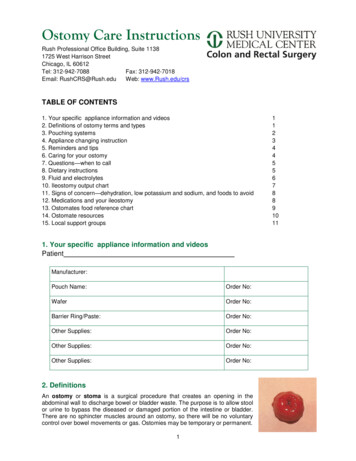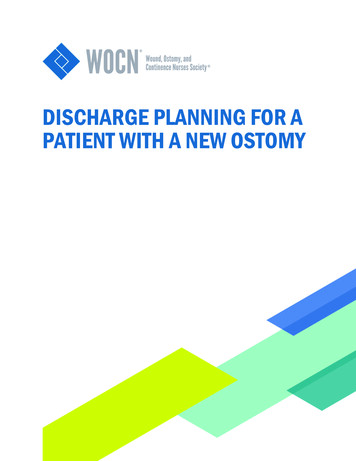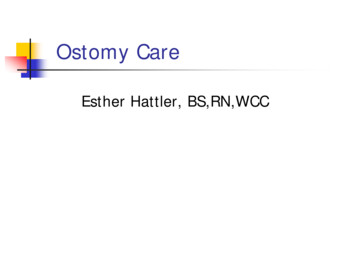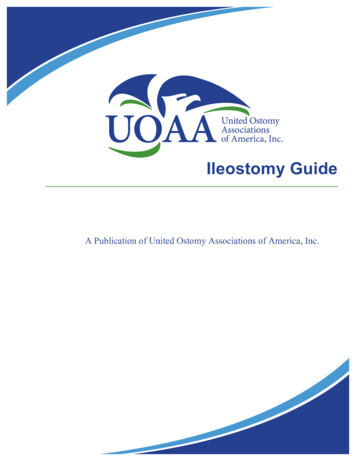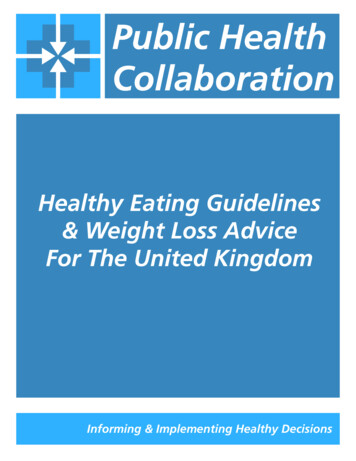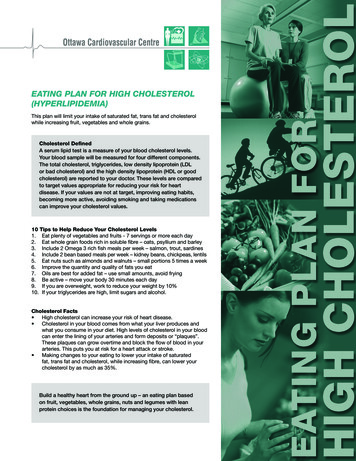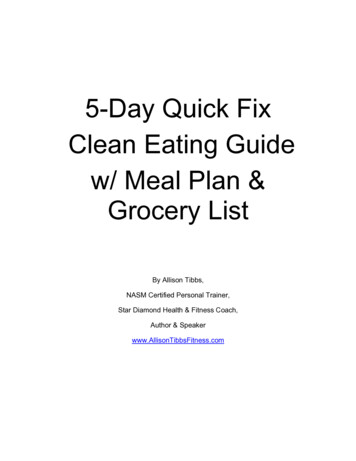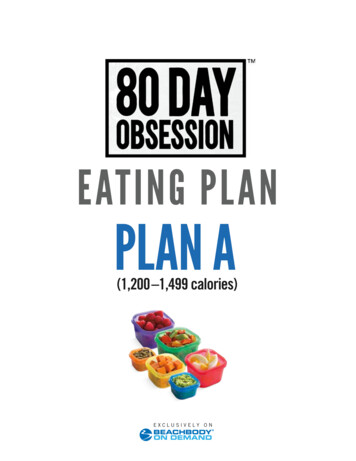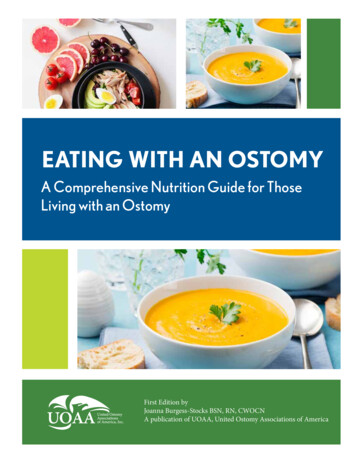
Transcription
1EATING WITH AN OSTOMYA Comprehensive Nutrition Guide for ThoseLiving with an OstomyFirst Edition byJoanna Burgess-Stocks BSN, RN, CWOCNA publication of UOAA, United Ostomy Associations of America
2The printing of this publication was made possible by generous contributions fromSherry Lessard, George & Linda Salamy and the San Francisco (Golden Gate)Affiliated Support Group.Copyright 2020 UOAA. All Rights Reserved.Disclaimer: This document contains information developed by United Ostomy Associations ofAmerica. This information does not replace medical advice from your health care provider. Youare a unique individual and your experiences may differ from that of other patients. Talk to yourhealth care provider if you have any questions about this document, your condition, or yourtreatment plan.
Table of Contents4Acknowledgements7Introduction9The Role of the Registered Dietitian11Nutrition 101—The Basics20Ostomy and the Digestive System26Ostomy and the Urinary System31Post-Operative Nutritional Guidelines: The First 4–6 Weeks35Ileostomy: Specific Post-Op Guidelines38Nutrition after Recovery and Beyond41Hydration, Fluids, and Electrolytes45Ostomy and Medications52Guidelines for a Continent Fecal Diversion55Short Bowel Syndrome60Resources63Glossary of Terms70Appendix:Food JournalFood and Their Effects ChartReferencesTestimonials
AcknowledgementsThank you to all who worked diligently in the creation of this nutrition guide for people livingwith or facing ostomy surgery. This document came to fruition with the help and expertise ofregistered dietitians, wound ostomy and continence nurses, medical educators, and patientreviewers. I have learned much about nutrition in this process, not only for myself, a nurse livingwith an ostomy, but also for my patients and loved ones. I am grateful for the community ofknowledge that is a part of this nutrition guide and look forward to it serving as a steady guidefor many navigating the world of eating with an ostomy.Joanna Burgess-Stocks, BSN, RN, CWOCNWakeMed Health and HospitalsNorth CarolinaAbout the Author:Joanna Burgess-Stocks lives in Apex, North Carolina with herhusband Ross. They consider themselves foodies and are alwayslooking for a new restaurant to try. Joanna has had a urostomysince the age of three due to bladder cancer. Later in life, she hadsurgery for a colostomy due to radiation induced colitis. She loveslife as an ostomy nurse and serves the ostomy community in bothhospital and outpatient settings. She has done volunteer work forthe Wound, Ostomy and Continence Nursing Society and servedon their National Ostomy Committee. Joanna currently serveson the UOAA Management Board of Directors and chairs theiradvocacy committee.
Advisors and ContributorsEditor and Content ReviewerJeanne Dagna, EdDAdjunct ProfessorImmaculata UniversityImmaculata, PennsylvaniaGut Microbiome, Prebiotics and ProbioticsVicki Jo Henry, Integrative Nutrition CoachSpokane, WANutrition and the Digestive SystemJoy Hooper, BSN, RN, CWOCN, OMS, WCCTifton, GeorgiaNutrition 101—The BasicsParul Kharod, MS, RD, LDNOutpatient Nutrition ServicesWakeMed Health & HospitalsNorth CarolinaFood Journal and Content ReviewerDr. Mary Arnold Long, DNP, APRN, CRRN, CWOCN-AP, ACNS-BCWOConsultation, LLCJohnson City, TennesseeFood and Hydration ChartsTara Wind, MS, RD, LDNEast Carolina UniversityGreenville, North Carolina
Advisors and Content ReviewersLois Fink, BSEdOstomy Patient AdvocateFort Collins, ColoradoMargaret Goldberg, MSN, RN, CWOCNPast President, National Pressure Ulcer Advisory PanelWound Ostomy and Continence Nurses SocietyDeerfield Beach, FloridaSara A. McKay, BSN, RN, CCRN, CWONCharleston Area Medical CenterCharleston, West VirginiaNihal E. Mohamed, PhDDepartment of Urology, Icahn School of Medicine, Mount Sinai Health SystemNew York, New YorkMichelle Pasia, MPH, RDNRWJ Barnabas HealthLivingston, New JerseyPaula Erwin Toth, MSN, RN, FAANDeerfield, OhioThis guide is available free in electronic form from United Ostomy Associations of America (UOAA).www.ostomy.org . info@ostomy.org . 800-826-0826
7IntroductionOstomy surgery is a life-saving procedure that allows bodily waste (urine or stool) to pass through asurgically created opening on the abdomen called a stoma. The waste passes into a prosthetic knownas an ostomy “pouch” worn on the outside of the body over the stoma. A continent ostomy has wastestored in an internal, surgically created pouch that is connected to a stoma on the abdomen that is emptied/drained by inserting a catheter (tube).Ostomy or continent diversion surgery restores health and enables a person to resume the activities theyonce enjoyed, such as traveling, playing sports, enjoying family life, working, and eating foods they mayhave had to avoid prior to surgery. Thousands of people of all ages undergo ostomy surgery each year asa result of complications from a variety of diseases, including bowel and bladder disease, and can returnto a healthy, functioning lifestyle.United Ostomy Associations of America (UOAA) is a not-for-How CanUOAAHelp?profit 501(c)(3) organization dedicated to helping those whohave had or will have ostomy or continent diversion surgery. Ourmission is to provide educational information, resources, support,and advocacy to promote a positive mindset and active qualityof life for those living with an ostomy or continent diversion.Our goal is to reassure all people that a full and productive lifefollowing ostomy surgery is completely possible.
8Life and health are built on eating good, nutritious food. Eating isWhy aGuide toNutrition?also central to our social interactions and how we celebrate familytraditions, holidays, culture, and ethnicity. It is natural for anyonewho has had ostomy or diversion surgery to have questions andeven concerns regarding their food choices and whether thecreation of an ostomy will change or alter their body’s ability to eatand digest the foods they enjoy.Having an ostomy does not mean that you must give up theenjoyment of eating. On the contrary, you will probably find thatafter your surgery you are eating and enjoying food more than youhave in a long time. Eating and good nutrition play an importantpart in recovery from any surgery, as well as in your overall generalstate of health. Often, by the time people experience surgery, theyare malnourished from years of living with an active diseaseand, as a result, it is common to have developed fears or confusionsurrounding healthy eating. In cases like these, registered dietitianscan assist a person in their recovery and support them to thrive astheir health restores.The goal of this UOAA Ostomy and Nutrition Guide is to provideanswers to many of your questions and help you feel moreconfident about the foods you eat as you recover from surgery.Remember, these are basic guidelines. You are a unique individualSee the Glossary ofTerms section at theback of this documentfor definitions of bluehighlighted words.and might have specific needs following surgery that go beyond orare different from what is included in this guide. That is why a crucialpart of your recovery is learning as much as you can about yourspecific nutritional needs in consultation with your physician or aregistered dietitian.
9The Role of a RegisteredDietitianA registered dietitian (RD) is an important part of your clinical care team. An RD can help you tobetter understand your nutritional needs before and after surgery.Often, by the time someone has ostomy surgery they have experienced nutritional deficits and adjustedtheir eating habits to cope with the complications of having a bowel disease such as Crohn’s disease orulcerative colitis. An RD can provide education and an individualized plan for a restorative diet. Whilenurses and wound/ostomy nurses can also assist in providing basic, post-surgical nutritional information, aconsultation with an RD offers more detailed information and ongoing follow-up after you are dischargedto home.Evaluate your personal preferences and nutritional needs basedWhat Can aRegisteredDietitianDo?on your medical history.Develop a personalized eating plan for you and your lifestyle.Establish dietary goals (gaining, maintaining, or losing weight).Help with meal planning.Assist with recognizing food allergies or sensitivities.Help interpret personal food journals; what is and what is notworking.Track your progress through your recovery.
10Many insurance companies cover the cost of services of a registereddietitian. You will most likely need a referral from your doctor to seeChoose aProfessionalan RD so be sure to contact your insurance company to verify theirrequirements.Check that the initials “RD” appear after the name of theprofessional you will be working with.Make sure the RD knows you have an ostomy and specifythe type—ileostomy, colostomy, urostomy, continent fecal, orcontinent urinary diversion—prior to your visit.Find a Registered DietitianNear YouIn Canada:Search a national database on the Dietitians of Canada website atwww.dietitians.ca/Find-a-Dietitian.aspxIn the United States:Check the following searchable databases:Academy of Nutrition and Dietetics “Eat national Foundation for Gastrointestinal Disorders (IFFGD):www.iffgd.org/dietitian-listing.htmlIn the UK:For general information about finding a dietitian in the UK through a referral from your doctor,visit itian.Search for a private dietitian in the UK on www.freelancedietitians.org/.
11Nutrition 101The BasicsThe old saying “You are what you eat” is true. What you eat and drink become the building blocks forall the cells in your body. Over time, your food and drink choices will make a difference in your overallhealth.Ostomy surgery should not change the way most people’s bodies digest, absorb, and usenutrients from food. The basics of nutrition apply to you and to everyone. The choices you make everyday will affect your health now and later in life.Each person is different. The best diet for you will depend on your body and medical history.Avoid random diets and learn to eat what is right for you. You can always get help from a registereddietitian (RD) to find the best diet for you.Learn to choose healthy foods from all food groups in the correctEatingWellamounts for your weight, body, and medical needs.Don’t eat too many foods with added sugars, sodium (salt), andsaturated and trans fats.When possible, get most of your nutrients from healthy foodsrather than from vitamin supplements. Talk to your doctor to findout if a vitamin supplement would benefit you.
12What you eat and drink is influenced by where you live, the types ofChallengesto EatingWellfoods available in your community, your budget, your culture andbackground, as well as your personal food preferences. Often thingsthat are not directly under your control—family responsibilities, workhours, etc.—can negatively affect your diet and food choices.Focus on making small changes in your daily life that will help you eathealthier without leaving you feeling overwhelmed.A Healthy Diet HelpsYour body and brain get the energy you need to think and bephysically activeYour body get the essential vitamins and minerals you needto stay alive and healthyYou reach and maintain a healthy weightPrevent, treat, and lower your risk of chronic diseases andtheir negative outcomesHelps your body maintain a healthy gut microbiomewhich affects many aspects of your health including aiding indigestion and benefiting your immune systemNutrition BasicsNutrients can be divided into two categories: macronutrients and micronutrients. Macronutrientsare those the body needs in large amounts. These provide the body with energy (calories). Micronutrientsare those nutrients that the body needs in smaller amounts but are equally important.MacronutrientsMacronutrients are essentially your calories. They are organized into three groups.CarbohydratesProteinsFatsBalance the macronutrients on your plate and you’ll have a healthy diet.
13CarbohydratesWe use carbohydrates for quick energy—they are your body’s favorite source of fuel. Our bodieseasily break down carbohydrates into glucose (sugar). Our brain and muscles are the biggest usersof glucose, but all the cells in our body use it to function. The amount of carbohydrates you needeach day can differ from one person to another and can be based on your daily activity level, weight,muscle mass and overall health.“Carbs” are not a specific food. They are one of the three major nutrients. Foods that havecarbohydrates are also important sources of fiber, vitamins, and minerals.Foods that contain carbohydratesGrainsBeansFruitsStarchy vegetablesMilkYogurt (a probiotic)Simple sugars, honey, maple syrup, agaveAdded sugar is in many processed, unhealthyfoods, pre-packaged foods, and beverages.Limit the amount of added sugars in your diet.Fiber is a carbohydrateMany people don’t realize that fiber is a type of carbohydrate.Fiber:Helps with feeling full for a longer timeHelps reduce sugar cravingsPrevents acid refluxPrevents constipationThere are two types of fiber, and most foods have a combination of the two: Soluble Fiber (dissolves in water) — helps to lower cholesterol levels and stabilizes bloodglucose. It also draws water into the gut to help soften stool.
14 Insoluble Fiber (cannot dissolve in water) —adds bulk to the stool, which helps the bodyeliminate stool more easily.Fiber foods are prebiotics that can help provide your body with a healthy variety of probioticbacteria in your gut.Best sources of fiber:Whole grainsNutsFruitsBeansSeedsVegetablesProteinProtein is the building block of the body and helps to produce the energy and materials needed forimportant life processes.Protein helps to:Build, repair and maintain cells, organ tissues, muscle, hair, skin, nails, bones, tendons,ligaments, and blood plasmaTransport nutri
Ostomy surgery is a life-saving procedure that allows bodily waste (urine or stool) to pass through a surgically created opening on the abdomen called a stoma. The waste passes into a prosthetic known as an ostomy “pouch” worn on the outside of the body over the stoma. A continent ostomy has waste
